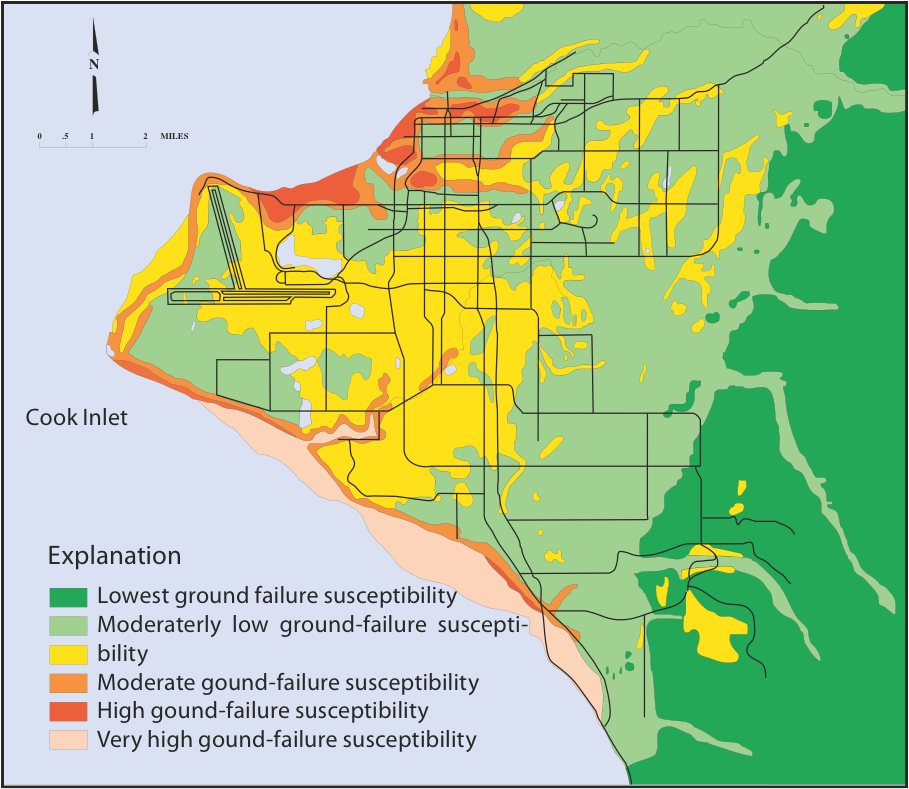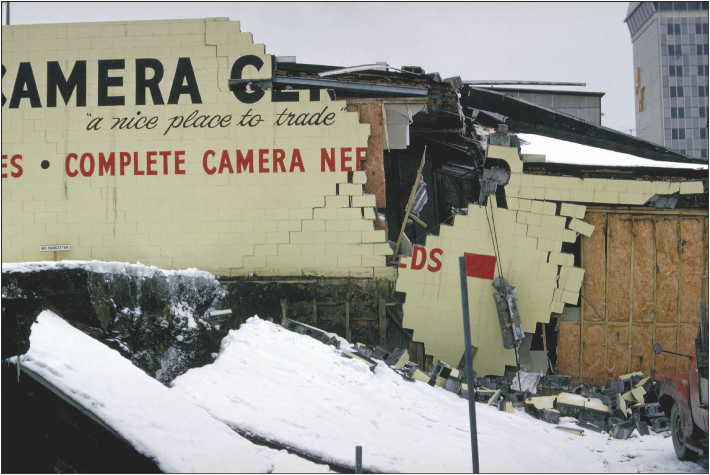Sometimes a caller will ask us, "Do I live on a fault?" If you live in the southern part of the state, the answer is yes. You live near the Alaska-Aleutian Megathrust, one of the most active and dangerous faults on Earth.
However, there is no place in Alaska where people do not have to think about earthquake safety. Dangerous earthquakes have happened all over the state. Remember that a small earthquake nearby can be just as destructive as a large earthquake far away.
Still, risk varies from place to place, from structure to structure, and from person to person. Informing yourself about the level of risk you face will help you decide how to prepare.
Places
The effects of an earthquake can be very different in places fewer than 100 yards apart. Fortunately, most areas that are prone to settle, slide, or shake violently can be identified beforehand.
Landslides are likely to be triggered by earthquakes on steep slopes and in areas underlain by soft ground. During the 1964 earthquake, Turnagain Heights slid towards the Knik Arm because it is underlain by soft, wet clay that is prone to sliding. The clay in the Anchorage area, and other types of soft ground, can also intensify and prolong and earthquake's shaking.
Even reasonably detailed maps give only an overview of the potential for shaking, liquifaction, landslides, faulting, and damage. To investigate a particular building site, you should consult an engineering geologist, geotechnical engineer, or a foundation engineer.

Relative chances of earthquake-induced ground failure in Anchorage area. Source: Anchorage Coastal Resources Atlas, v. 1, Anchorage Bowl. Available online at www.dggs.alaska.gov (Publication MP32)
Structures
Buildings constructed according to modern codes generally perform very well during earthquakes. However, certain types of buildings, especially older ones, are potentially hazardous.
Unreinforced brick buildings can be dangerous even in moderate earthquakes. Buildings with a "soft" first story are also vulnerable. Usually, soft stories consist of open space with columns rather than walls supporting the building above. Many garages, stores, and large offices are built like this. Similarly, older split-level homes and rooms added above private garages may not be adequately supported.
Mobile homes, portable classrooms, and modular buildings can slide or bounce off their foundations during earthquakes. Their supports need to be braced to resist vertical and horizontal forces. If portable classrooms are used at your local school, you should ask school officials whether they are properly braced.
One or two-story wood-frame buildings are not likely to collapse, although houses that are not adequately bolted to their foundation may fail at or near ground level.
If you are concerned about your home, ask a licensed engineer or architect to look at it and discuss the seismic issues with you. A written report and specifications for corrective action may involve more time. Consider asking for a seismic inspection before buying a new home.
If you belive that another structure that you or your family uses is hazardous, ask the building owner what consideration has been given to seismic design and strengthening.
People
Some people are more vulnerable that others during and earthquake. People with mobility issues, special health care needs, or limited English proficiency all face greater challenges immediately after an earthquake. The very young and the very old are always of special concern.
If members of your family or household are especially vulnerable, plan for how you will care for them during and after an earthquake. Consider your neighbors as well. Who among them is most likely to need help? Once you are safe, ask yourself where your assistance will be most valuable.

Unreinforced masonry structures are especially prone to failure.






